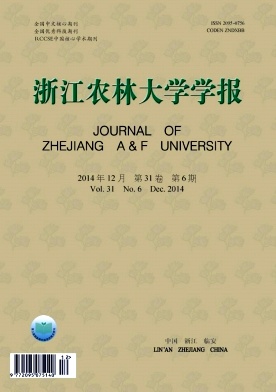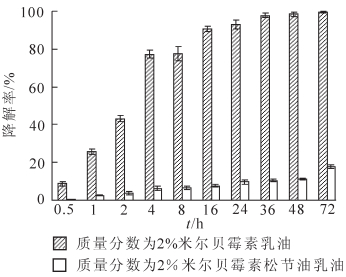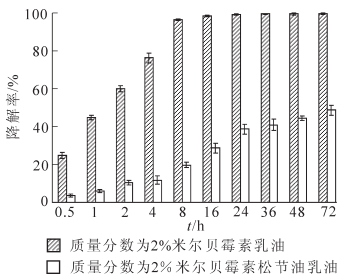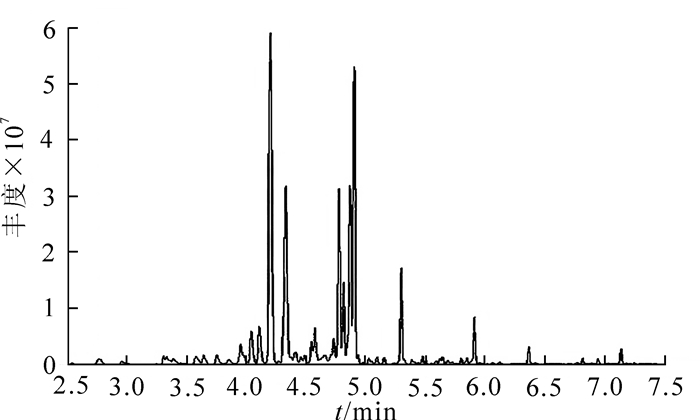-
米尔贝霉素(milbemycins)是1967年日本Sankyo公司以二斑叶螨Tetranychus urticae为试虫筛选出的微生物代谢产物。1983年开发出了米尔贝霉素A3和A4组分的混合物[m(A3):m(A4)=3:7]为有效成分的杀螨剂[1]。米尔贝霉素具有活性高,毒性低,对环境污染小,对人畜安全等优点[2]。它和阿维菌素一起被誉为当今活性最高的杀虫剂,是目前最有应用前景的生物农药之一[3]。作为微生物源农药,米尔贝霉素和阿维菌素特性相同,米尔贝霉素在阳光、紫外光下易分解[4]。这一特性也限制了米尔贝霉素的开发和利用。阿维菌素和矿物油一起使用时,可延长阿维菌素的防治效果和药效期[5],这也是米尔贝霉素开发需要解决的问题。松节油是松树上采集的松脂经加工得到的化工产品,它是世界上产量最大、价格最为便宜的植物精油[6]。松节油绿色环保、安全无毒,对米尔贝霉素有良好的溶解性。本研究拟在此基础上,探讨松节油对米尔贝霉素的增效和稳定性作用,为开发以松节油为溶剂的米尔贝霉素绿色乳油制剂提供依据。
HTML
-
朱砂叶螨Tetranychus cinnabarinus:由浙江省化工研究院提供,在人工气候室条件下[(26±1)℃,相对湿度为(70±5)%,光周期为14 h/10 h],接种于蚕豆苗上培养。
-
松节油(150~270 ℃的馏分,江西吉安市国光香料厂);质量分数为95%米尔贝霉素原药[Milbemycin,m(A3):m(A4)=3:7],由浙江海正药业有限公司提供;试剂均为分析纯,市购。
-
Waters 600高效液相色谱仪;ZF-20D暗箱式紫外分析仪;Potter喷雾塔(英国Burkard仪器公司);奥林巴斯解剖镜SZ2-LGB(中国上海赖氏科技有限公司);Agilent technologies气质联用色谱仪(7890A GS system,7693Autosampler,5875C insert MSD),HP-INNOWAX毛细管柱(30 m × 0.32 mm × 0.50 μm),Agilent化学工作站。
-
制剂配制:准确称取一定质量的米尔贝霉素原药,分别用松节油和乙醇为溶剂、OP10为乳化剂配成乳油:质量分数为2%米尔贝霉素乳油(米尔贝霉素1.0 g,乙醇45.0 g,OP10 4.0 g);质量分数2%米尔贝霉素松节油乳油(米尔贝霉素1.0 g,松节油45.0 g,OP10 4.0 g);质量分数为90%松节油乳油(松节油45.0 g,OP10 5.0 g)。用蒸馏水将各制剂稀释成系列质量浓度药液。米尔贝霉素制剂稀释质量浓度梯度为0.025,0.050,0.100,0.200,0.400,0.800 mg· L-1,松节油稀释100,250,500,1 000,2 000,4 000,6 000倍。采用叶碟喷雾法[7]测定各制剂对朱砂叶螨的活性。使用POLO软件处理数据,用几率值分析法计算各化合物的毒力回归方程、半致死浓度(CL50值)、95%置信限和相关系数。用共毒系数(CTC)[8]来判断松节油对米尔贝霉素的增效作用。
-
紫外光光解稳定性测定。采用玻璃膜状光解稳定性试验方法[9]。分别取质量分数2%米尔贝霉素乳油和质量分数2%米尔贝霉素松节油乳油(高效液相色谱法HPLC测定其含量)1.0 mL置于Φ2 cm的培养皿中(按照光照时间标记培养皿,每时间段设3个重复),立即放入暗室中,室温下待溶剂在自然状态下完全挥发后,形成面积为培养皿底面的药剂薄膜,放入ZF-20D暗箱式紫外分析仪下(培养皿距离紫外灯管20 cm,对照用锡纸遮盖),用波长为254 nm的紫外光照射,紫外光光照强度为420 lx,经0.5,1.0,2.0,4.0,8.0,16.0,24.0,36.0,48.0,72.0 h取样,将药膜用5.0 mL甲醇分3次振荡溶解后转移到棕色样品瓶,HPLC测定其质量分数,用式(1)计算米尔贝霉素各制剂的紫外光分解率。
太阳光光解稳定性测定。同样采用玻璃膜状光解稳定性试验方法。将涂有米尔贝霉素制剂的培养皿置于室外阳光下照射,对照用锡纸遮盖,光照强度1 200~1 500 lx(光照时间累积计算,8 h·d-1),夜间或阴天将培养皿密封置于冰箱存放。经0.5,1.0,2.0,4.0,8.0,16.0,24.0,36.0,48.0,72.0 h照射时间后分别取样检测质量分数变化,按(1)式求出光解率。
-
质量分数2%米尔贝霉素乳油和质量分数2%米尔贝霉素松节油乳油各取25.0 mL,密封于安瓿瓶内,分别进行冷储和热储试验,重复3次·试验-1。于0 ℃冰水浴冷储7 d,(54±2)℃热水浴热储14 d,测定储存前后质量,按式(2)计算冷储和热储降解率。
-
采用高效液相色谱分析米尔贝霉素含量。Waters symmetry C18色谱柱(250 mm × 4.6 mm × 5.0 μm),分析米尔贝霉素以V(甲醇):V(水)=95:5为流动相,V(乙腈):V(甲醇):V(体积分数为0.1%的三乙胺)=56:28:16,检测波长243 nm,进样量20 μL,流速1.0 mL·min-1,米尔贝霉素A3和A4保留时间分别为15.48 min和21.15 min。
-
气相色谱条件:HP-INNOWAX毛细管柱,起始温度60 ℃,保持2 min,以30 ℃·min-1升至190 ℃,再以10 ℃·min-1升至230 ℃,保持10 min。氦气为载气,流速1.0 mL·min-1,进样量1.0 μL,分流比10:1;进样口温度250 ℃,检测器温度250 ℃。质谱条件:EI离子源能量为70 eV,扫描范围为30~250。
1.1. 供试昆虫
1.2. 供试药剂
1.3. 仪器
1.4. 实验方法
1.4.1. 对叶螨雌成螨的毒力测定
1.4.2. 松节油对米尔贝霉素的光解稳定性
1.4.3. 松节油对米尔贝霉素冷储和热储稳定性
1.5. 松节油含量及成分分析
1.5.1. 米尔贝霉素含量分析
1.5.2. 成分分析方法
-
各供试制剂对朱砂叶螨雌成螨的毒力测定结果见表 1。松节油单独使用时对朱砂叶螨的半致死质量浓度(CL50)为227.050 3 mg· L-1,活性较低。松节油为溶剂配制的米尔贝霉素乳油对朱砂叶螨半致死质量浓度为0.031 4 mg· L-1,乙醇为溶剂的米尔贝霉素乳油对朱砂叶螨半致死质量浓度为0.139 0 mg· L-1,松节油对米尔贝霉素的共毒系数为442.68,表现出显著的增效作用。
药剂 毒力回归方程 半致死质量浓度/(mg·L-1) 相关系数 95 %置信限/(mg·L-1) 共毒系数 松节油 y=2.516 6+1.054 04x 227.050 3 0.988 0 221.280 5~232.973 1 米尔贝霉素/乙醇 y=6.644 7+1.919 4x 0.139 0 0.966 8 0.131 5~0.258 0 米尔贝霉素/松节油 y=9.564 2+3.036 0x 0.031 4 0.965 4 0.037 7~0.054 9 442.68 Table 1. Toxicity of turpentine and milbemycin to female adult of Tetranychus cinnabarinus
-
由图 1可见:在波长254 nm光照条件下,质量分数为2%米尔贝霉素乳油紫外光照射下的降解率要显著高于质量分数为2%米尔贝霉素松节油乳油在紫外光下的降解率。在紫外光光照72 h后,2%米尔贝霉素乳油降解率接近100%,而2%米尔贝霉素松节油乳油降解率则为17.76%。
由图 2可见:在1 200~1 500 lx光照条件下,2%米尔贝霉素乳油的降解率要显著高于质量分数为2%米尔贝霉素松节油乳油的光照降解率。在光照12 h后,2%米尔贝霉素乳油降解率达到98.37%,而质量分数为2%米尔贝霉素松节油乳油降解率则为28.72%;在光照72 h后,质量分数为2%米尔贝霉素乳油已基本分解,2%米尔贝霉素松节油乳油降解率为48.61%。
-
从表 2中可知:2种米尔贝霉素乳油经冷、热储后的有效成分的降解率均小于5%,外观无沉淀和分层现象符合制剂冷、热储要求。
储存方式 药剂 冷/热储前质量/mg 冷/热储后质量/mg 降解率/% 外观 冷储 2%米尔贝霉素乳油 509.25 495.38 2.72 透明均一 2%米尔贝霉素松节油乳油 516.00 509.70 1.22 油状透明均一 热储 2%米尔贝霉素乳油 509.25 493.73 3.05 透明均一 2%米尔贝霉素松节油乳油 516.00 491.93 4.67 油状透明均一 Table 2. Cold storage, heated storage to stability influence of milbemycin
-
采用毛细管柱,在所设定的条件下对松节油进行检测,松节油总离子流图见图 3。从图 3中可以看出:在4.0~7.5 min为松节油的特征峰范围,保留时间为4.203 min时的色谱峰,丰度明显高于其他峰,经数据库比对确定该物质为松节油主要成分α-蒎烯。松节油中相对含量大于1%的成分及其分子结构见表 3。供试松节油中,含量超过1%的成分多为单萜类同分异构体,相对含量最高为α-蒎烯(19.84%),其次为(R)-苧烯(11.70%),莰烯(10.33%)和3-蒈烯(7.29%)。
名称 相对含量/% 保留时/min 分子式 2-莰烯 1.63 3.95 C10H16 1, 3, 5, 5-四甲基-1, 3-环己二烯 1.84 4.04 C10H16 (1S)-3, 7, 7-三甲基双环[4.1.0]庚-3-烯 2.10 4.11 C10H16 α-蒎烯 19.84 4.20 C10H16 莰烯 10.33 4.33 C10H16 葑酮 1.05 4.55 C10H16O 1, 3, 5, 5-四甲基-1, 3-环己二烯 1.77 4.57 C10H16 γ-松油烯 1.25 4.73 C10H16 3-蒈烯 7.22 4.72 C10H16 萜品油烯 3.36 4.81 C10H16 1-甲基-2-异丙基苯 8.49 4.87 C10H16 (R)-苧烯 11.70 4.91 C10H16 萜品油烯 3.31 5.30 C10H16 2-甲氧基-4-甲基苯酚 1.82 5.91 C8H10O2 Table 3. GC-MS analysis results of turpentine
2.1. 松节油及米尔贝霉素制剂对朱砂叶螨雌成螨的毒力测定
2.2. 松节油对米尔贝霉素光解稳定性测定
2.3. 松节油对对米尔贝霉素的冷、热储稳定性测定
2.4. 松节油成分分析
-
松节油是松树Pinus上采集的松脂经加工得到的化工产品,它是世界上产量最大、价格最为便宜的植物精油。中国松树资源丰富,松树面积约1 600 × 104 km2,年产松节油约8 × 104 t,仅次于美国,位居世界第2位[6]。松节油具有一定的生物活性,可直接用于治疗肌肉痛、关节痛、神经痛和软组织损伤,还可作为药物助剂,如溶剂、杀菌消毒剂和透皮促进剂等[10-11]。目前松节油多用于合成龙脑、薄荷脑、维生素类、药用樟脑等[12],农药制备方面多用于开发杀虫增效剂、萜类驱避剂、拒食剂和保幼激素类似物等[13]。研究表明:松节油对米尔贝霉素有显著的增效作用,光解、冷热储试验表明:松节油对提高米尔贝霉素稳定性也具有很好的效果,气相色谱-质谱联用仪(GC-MS)分析其主要成分为α-蒎烯,(R)-苧烯、莰烯和3-蒈烯[14]等萜烯类化合物。萜烯类化合物具有良好的脂溶性,对昆虫表皮有较强的渗透作用[15],是松节油对米尔贝霉素增效的主要原因。
松节油对米尔贝霉素还具有较强的稳定作用,是其增效的另一原因。米尔贝霉素在环境中的稳定性相对较差,在强阳光下容易分解,这也是生物源农药的共同特点。例如紫外线能使印楝素快速分解[9],印楝素-A涂敷成薄膜在紫外灯照射下的半衰期只有48 min[16]。阿维菌素在阳光照射下,半衰期<10 h[17-19]。生物源农药的不稳定性严重限制了它们的田间使用,从而使其商品化进程缓慢。而以松节油为溶剂在抗紫外、抗强阳光、制剂的冷、热储方面,对米尔贝霉素都能够起到很好的稳定作用。以松节油为溶剂配制的其他药剂对小菜蛾Plutella xyllostella,蚜虫Aphis craccivora,菜青虫Pieris rapae,东方黏虫Mythimna separata的室内毒力结果表明:药剂均表现出良好的增效作用,昆虫也表现出良好的拒食作用[20]。
农药乳油制剂加工成本低、使用方便,田间效果优于相同成分的其他类型制剂,但使用大量的有机溶剂会对环境造成极大的压力。松节油来源丰富,价格适中,对米尔贝霉素有良好的溶解性,并具有显著的增效和稳定作用,是米尔贝霉素绿色乳油制剂加工的良好溶剂选择。













 DownLoad:
DownLoad:

